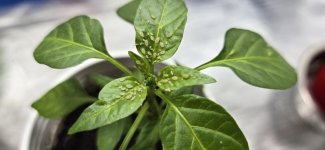Clearly your indoor Cayennetta pepper plants is dealing with aphids, especially since the insects don’t move and are found on the new leaves. Aphids are tiny, soft-bodied insects that can be green, black, or brown, often clustering on new growth and causing curling or yellowing leaves. To manage them, inspect your plants closely for any movement or the presence of honeydew, a sticky residue they leave behind. You can manually remove the aphids by gently wiping them off with a damp cloth or cotton swab, and if there's a large infestation, consider pruning off heavily-infested leaves. Natural remedies like neem oil can be effective; just mix it according to the label directions and spray it on the affected areas. Insecticidal soap can also help, so ensure to cover both the tops and undersides of the leaves. Introducing beneficial insects, such as ladybugs or lacewings, can provide additional control. Maintaining good air circulation around your indoor plants can deter pests, so keep an eye on them and monitor for signs of aphids regularly. Ensure your plants are healthy by providing proper light, watering, and nutrition, as stress can make them more susceptible to pests. As a preventive measure, always quarantine new plants for a few weeks to monitor for pests before adding them to your indoor garden, and maintain cleanliness by removing fallen leaves or debris. Taking these steps should help you manage aphids effectively while keeping your Cayennetta pepper plants healthy.






